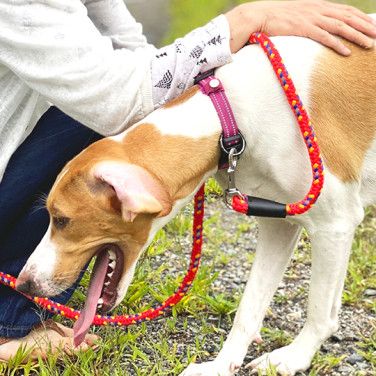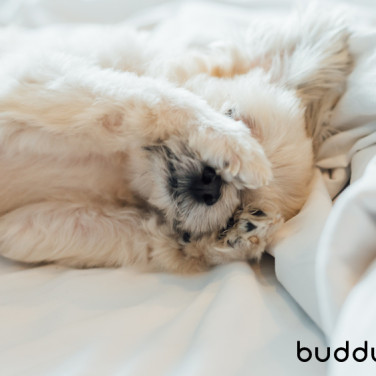SYMPTOMS
Common Types of Eye Discharge in Dogs - Causes and Treatments
페이지 정보
본문


What is eye discharge in dogs?
Eye discharge is a common problem for some dogs and can manifest in various forms, ranging from tears to mucous discharge. Some types of eye discharge in dogs can be considered normal and have natural causes such as when a foreign object enters the eye and tears are produced to remove them and the seasonal allergies. While other types can indicate a more serious condition such as infection and diseases like glaucoma. For instance, an off-white mucous discharge could indicate a disease like keratoconjunctivitis, while a yellow or green discharge could signal an eye infection. If there is an increase in discharge or a color change, it is recommended to visit the hospital for a thorough examination.
Common causes of eye discharge in dogs

Clear tears are signs of a healthy eye, producing discharge to protect the cornea and provide sufficient moisture, or wash away impurities like dust that enter the eye. However, if the amount or consistency of eye discharge appears uncommon or excessive, it could signify an underlying eye health issue.
Common causes of eye discharge include:
Glaucoma is an eye disease caused by excessive pressure on the eye, which can cause pain and discharge as the eye becomes cloudy.
-
Allergic reaction
Many substances can trigger an allergic reaction, with common culprits being pollen and dust. When an allergic reaction affects the eyes, excessive secretion of clear tears is the main symptom of this type of reaction.
-
Foreign matter
Eye discharge may be produced when a foreign object enters the eye to remove it.
-
Infection
Bacterial or viral infections can cause eye discharge. In particular, the canine distemper virus causes a lot of eye discharge.
-
Dry eyes
Dogs who cannot produce tears well will be unable to wash out impurities well and as a result, a sticky ocular secretion may appear.
-
Epiphora
Excessive tear production, or epiphora, can cause discoloration of the hair around the eyes and produce a foul odor.
-
Conjunctivitis
Conjunctivitis is an inflammation of the conjunctiva that can cause a range of symptoms, including yellow to green eye discharge or excessive tear production. Other key symptoms include red eyes, difficulty opening the eyes, and excessive blinking. Conjunctivitis can be caused by allergies, trauma, or tear duct problems.
-
Corneal ulcers
Corneal ulcers are when the cornea is damaged, or inflamed for several reasons, and part of the cornea becomes pitted, causing pain in the eye, redness of the eye, and excessive tearing.
-
Genetic factors
Brachycephalic breeds, such as Pugs and Pekingese, are prone to having more eye discharge due to the increased exposure of their eyes. Additionally, inward rolling of the eyelids, known as entropion, is a common condition in these breeds that can lead to eye irritation and discharge.
Glaucoma is an eye disease caused by excessive pressure on the eye, which can cause pain and discharge as the eye becomes cloudy.
Types of eye discharge in dogs
-
Excessive tear production (Watery eyes)
Excessive tearing can occur due to a variety of reasons, such as irritation, allergies, foreign bodies, or issues with the tear duct. These causes can lead to the overproduction of tears, also known as epiphora, and range in severity from relatively normal to something serious. A good rule of thumb is if the excessive tears persist for more than a day or two or your dog develops red, painful eyes. That is a good sign to take your dog’s epiphora seriously and visit a vet to determine the exact cause.
-
A little goop or crust
Tears are drained through tear ducts positioned at the inner corners of each eye. As dry tears, oil, and mucus build-up, it forms eye boogers or goop. This discharge is considered normal and can be effortlessly removed using a tissue or cloth soaked in water. If your dog shows signs of discomfort or their eyes become red, it is a good sign to visit the vet to determine the exact cause.
-
Reddish-brown tear stains
Due to the presence of a component called porphyrin in tears, which turns reddish brown after prolonged exposure to air, the hair in the area where tears flow may become discolored. This discoloration may be more noticeable if a dog has light-colored hair. However, if there are no other underlying issues, reddish-brown tear stains are considered normal. It is advisable to clean tears regularly to minimize staining.
-
White-gray mucous
When tear production is reduced, either due to dry eyes or diseases like keratoconjunctivitis, the body compensates by secreting excess mucus discharge. These substances serve as a substitute for tears. However, despite their presence, the eyes may still experience redness and pain. This is because the mucous substance is not able to fully replicate the beneficial effects of tears. If you notice an off-white gray eye discharge, it is best to make an appointment with a veterinarian for treatment.
-
Yellow or green eye discharge
If your dog has any yellow or green discharge secreted from the eyes, it is typically an indication of infection or another underlying condition. This type of eye discharge can be a sign of a systemic illness within a dog’s respiratory tract or nervous system. It is vital if your dog shows any sign of this type of discharge, to visit a vet as soon as possible.
When to visit a vet for eye discharge in dogs
If your dog experiences any of the following signs, it is recommended to visit a vet to determine the cause as soon as possible.
- Changes in the color of eye discharge, such as from clear to yellow or green
- Amount of eye discharge increases
- If your dog is rubbing its eyes or blinking excessively, or begins squinting
- Eye discharge persists for more than 2-3 days
- Red, bloodshot, or cloudy eyes
- Eyes are swollen or show difficulty opening eyes
- Abnormal eye discharge accompanied by symptoms such as sneezing, nasal discharge, decreased appetite, or lethargy
Home treatment for a dog with eye discharge at home
When eye discharge occurs, frequent wiping with a fresh cotton ball can help manage both discoloration and odor. Always consult with a veterinarian when considering using an over-the-counter eye drop solution for your dog. Monitor your pet for any other signs of underlying causes that can help a veterinarian determine the cause of your pet’s symptoms. If your pet shows any of the signs listed above, it is best to have your pet examined and treated by a veterinarian.
Diagnosing eye discharge in dogs
When you visit the vet to diagnose your pet’s eye discharge, your veterinarian will ask about your dog’s overall condition to better understand the circumstances to narrow down the diagnosis process. Afterward, they will examine the eyes and perform any necessary tests to determine the underlying issue.
Some questions your veterinarian may ask:
- When did you first notice the discharge?
- What color is the secretion?
- Does your dog rub its eyes frequently?
- Is your dog vaccinated regularly?
Based on the guardian's answer, the following tests can be performed for a more accurate diagnosis.
-
Measurement of tear amount
The dog's tear volume is measured to ensure whether the normal amount is being secreted.
-
Corneal ulcer test
A specialized fluorescent drug is administered into the eye to detect the presence of ulcers, which are then observable through the staining of the affected area by the fluorescent drug.
-
Intraocular pressure test
Check that intraocular pressure is within the normal range.
Treatment for eye discharge in dogs

The treatment for eye discharge problems typically involves addressing the underlying condition that is causing the discharge. In cases where the discharge is the result of an infection, eye drops and ointments can be prescribed to combat the infection. However, if the discharge is caused by a blockage of the tear duct, surgical intervention by a specialist may be required.
How to prevent eye discharge in dogs
To prevent eye discharge in dogs, it's important to pay attention to signs of discomfort in your dog's eyes, as well as the amount and color of the discharge. Grooming is crucial to avoid long hairs from irritating your pet’s eyes. Additionally, it's essential to be careful not to allow any foreign substances that can cause eye irritation, such as shampoo and soap, to come into contact with the eyes. As long as you pay close attention to their eyes, and ensure no symptoms go untreated for more than a few days.
Find out more about your dog’s symptoms and diseases on the Buddydoc app!

The Buddydoc library is filled with everything you’d want to know about each symptom and disease your pet may experience. If you would like to find out more about the causes, signs, treatments, preventions, and more for your dog’s disease. Try out the Buddydoc app and search for your pet’s symptoms or diseases in the Buddydoc library.













